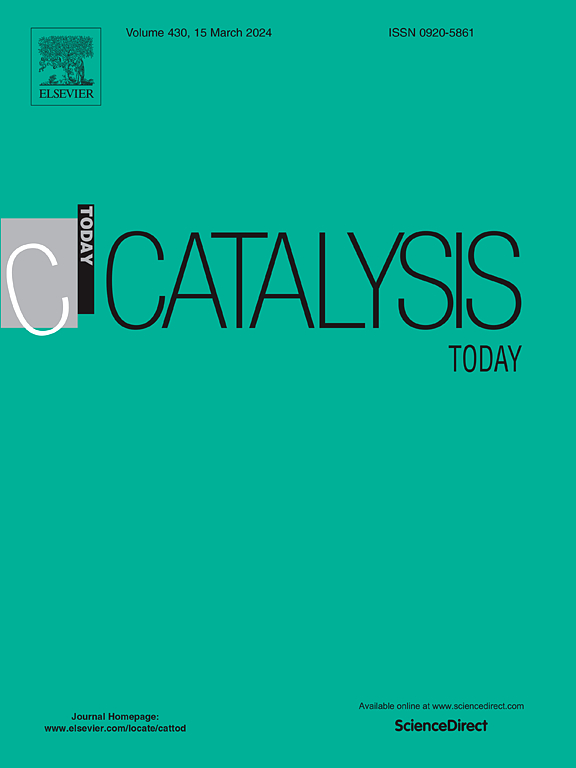Sn-silica catalyzes cheese whey to lactic acid in a fluidized bed reactor
IF 5.2
2区 化学
Q1 CHEMISTRY, APPLIED
引用次数: 0
Abstract
Worldwide, the dairy industry produces 200 million tons per year of whey. Among the most abundant components of cheese whey is lactose, a low-priced raw material for nutraceuticals, animal feed, and high value products such as lactic acid (LA)., a specialty chemical platform in the pharmaceutical, cosmetic, and in the food industry, and is the precursor to polylactic acid, a biodegradable polymer. Here, we propose a fluidized bed process that atomizes an aqueous lactose solution directly into a catalytic bed operating at 325∘C to produce LA. We synthesized silica supported Sn catalysts by varying the metal loading (from 0 to 0.1 g g−1 of Sn) and analyzed its physicochemical properties. This research highlights the critical role of Sn as an active site to hydrolyse/isomerize/retro-aldol/dehydrate/crack lactose to lactic acid in a gas phase environment. All catalysts achieved complete conversion. SiO2 impregnated with 0.1 g g−1 Sn catalyst achieved the maximum lactic acid yield of 23 % at 2 h of the reaction. Lactic acid yield declined thereafter due to coke blocking the active catalytic sites. XPS, Raman and CHN analysis highlighted changes in carbon distribution and evidence of coke accumulation in the spent catalyst. This article brings new findings related to significant challenges related to the continuous operation of a fluidized bed reactor in the conversion of lactose and strategies to mitigate agglomeration and coke formation.
锡硅在流化床反应器中催化奶酪乳清生成乳酸
在世界范围内,乳制品行业每年生产2亿吨乳清。奶酪乳清中最丰富的成分是乳糖,它是营养食品、动物饲料和高价值产品(如乳酸)的低价原料。是一种用于制药、化妆品和食品工业的特殊化学平台,是聚乳酸的前体,聚乳酸是一种可生物降解的聚合物。在这里,我们提出一种流化床工艺,将乳糖水溶液直接雾化到325°C的催化床上,以产生LA。我们通过改变Sn的金属负荷量(从0到0.1 g g−1)合成了二氧化硅负载的Sn催化剂,并分析了其物理化学性质。本研究强调了Sn作为活性位点在气相环境下水解/异构化/反醛醇/脱水/裂解乳糖为乳酸的关键作用。所有催化剂均实现了完全转化。用0.1 g g−1 Sn催化剂浸渍SiO2,在反应2 h时乳酸产率达到最大,为23 %。由于焦炭阻塞了活性催化位点,乳酸产率随后下降。XPS,拉曼和CHN分析强调了碳分布的变化和废催化剂中焦炭积累的证据。本文介绍了在乳糖转化过程中流化床反应器连续运行所面临的重大挑战,以及缓解结焦和结焦的策略。
本文章由计算机程序翻译,如有差异,请以英文原文为准。
求助全文
约1分钟内获得全文
求助全文
来源期刊

Catalysis Today
化学-工程:化工
CiteScore
11.50
自引率
3.80%
发文量
573
审稿时长
2.9 months
期刊介绍:
Catalysis Today focuses on the rapid publication of original invited papers devoted to currently important topics in catalysis and related subjects. The journal only publishes special issues (Proposing a Catalysis Today Special Issue), each of which is supervised by Guest Editors who recruit individual papers and oversee the peer review process. Catalysis Today offers researchers in the field of catalysis in-depth overviews of topical issues.
Both fundamental and applied aspects of catalysis are covered. Subjects such as catalysis of immobilized organometallic and biocatalytic systems are welcome. Subjects related to catalysis such as experimental techniques, adsorption, process technology, synthesis, in situ characterization, computational, theoretical modeling, imaging and others are included if there is a clear relationship to catalysis.
 求助内容:
求助内容: 应助结果提醒方式:
应助结果提醒方式:


